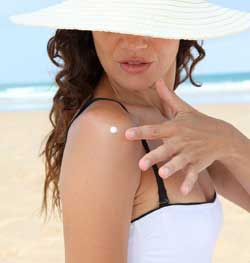You have no items in your shopping cart.
Problems Adding to Cart? Click here for assistance.

It's spring, which means you've probably already had that moment at the drugstore where you stood in the sunscreen aisle staring at ingredient labels and silently crying. Sunscreen is kind of a grey area for us. After all, it's vital for healthy skin, but its long-term effect on our health is still a mystery. But regardless of where you stand on the debate, you simply can't flounce around in the sun without sunscreen. So before you mistakenly pick up that bottle of Sports Performance Sunscreen Spray with SPF 100 (don't do it!), here are some easy tips on what to look for when picking a sunscreen:
Found in chemical sunscreens, oxybenzone penetrates the skin, producing harmful free radicals while also attacking DNA cells. Vitamin A, or retinyl palmitate, is an ingredient that's harmful once exposed to sunlight, producing free radicals when exposed to UVA radiation. Other ingredients to look out for that aren't as harmful but might cause allergic reactions are octocrylene and octinoxate.
This is the safest ingredient, according to the EWG. Along with titanium dioxide, these are typically found in mineral sunscreens and are considered safer since they don't penetrate the skin and offer broad spectrum protection against UVA and UVB rays. Although some studies have shown that titanium dioxide can work as a photosensitizer that can be absorbed by the skin, so a safe bet is to look for sunscreens that are known to use particles too big to be absorbed.
These spray sunscreens might look convenient but have inhalation risks. While the FDA has expressed concern over the products, there has been no official word on its harmful effects. To be safe, it's best to avoid.
Natural antioxidants are the latest breakthrough in sunscreens and are a safe way to boost our natural immunity to the sun's harmful rays. When layered or combined with a sunscreen, they add an extra level of protection. Some known antioxidants are raspberry seed oil, astaxanthin, ferulic acid and reishi mushrooms. We recommend Suntegrity 5-in-1 Natural Moisturizing Face Sunscreen ($45 in the shop) or MD Solar Sciences Mineral Crème SPF 50 ($30 in the shop) for an antioxidant-rich sunscreen.
Don't be fooled by sunscreens boasting SPFs higher than 50. These sunscreens might trick you into thinking you're protected but can still do harm. SPF only measures UVB radiation, not UVA. So even if a high SPF sunscreen keeps you from getting sunburned, it might not protect from the more harmful effects, like cancer or melanoma. Stick to sunscreens that have a SPF between 30 to 50.
Sunscreen should be reapplied every two to three hours. Don't be fooled by waterproof sunscreens. Those eventually wash off as well.
A tanning oil does not provide the adequate amount of sunscreen needed to protect you from the sun and should not be mistaken for a bona fide sunscreen.
No matter how strong your sunscreen is, sometimes the best protection is avoiding the sun's rays directly. Make sure to always wear sunglasses, keep a hat handy and stay out of the sun during peak hot times. Your skin will thank you for it.




April 28, 2015
by Block Island Organics
Great article! Sun protection education is so important. Particularly with the rise of skin cancer. Thanks for sharing!